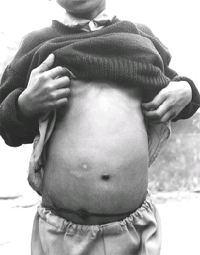The black fever
 The world is shrinking for Santosh Kumar Manjhi. Bedridden for the past few months, the boy looks much too young for his 13 years of age. His world is limited to his small room in village Capshar in district Saran of northern Bihar. His stomach is swollen, his body reduced to a skeleton. He has kala-azar, the black fever, also known as leishmaniasis. It is transmitted through the bite of the sandfly ( Phlebotomus argentipes ) infected with the parasite Leishmania donovani . It causes emaciation, enlargement of the spleen and liver, anaemia and fever, and in chronic cases leads to darkening of the skin, hence the name. Thought to have been eradi cated in India, it is back in Bihar, killing scores and abandoning thousands to the vagaries of a medical system that is indifferent at its best and as bad as the disease at its worst.
The world is shrinking for Santosh Kumar Manjhi. Bedridden for the past few months, the boy looks much too young for his 13 years of age. His world is limited to his small room in village Capshar in district Saran of northern Bihar. His stomach is swollen, his body reduced to a skeleton. He has kala-azar, the black fever, also known as leishmaniasis. It is transmitted through the bite of the sandfly ( Phlebotomus argentipes ) infected with the parasite Leishmania donovani . It causes emaciation, enlargement of the spleen and liver, anaemia and fever, and in chronic cases leads to darkening of the skin, hence the name. Thought to have been eradi cated in India, it is back in Bihar, killing scores and abandoning thousands to the vagaries of a medical system that is indifferent at its best and as bad as the disease at its worst.
"He was almost dead,' says Kalavati Devi, Santosh's mother. Her husband died two years ago.There is no monetary help, and she is finding it very difficult to consult a specialist in the state capital Patna. She has already spent more than Rs 2,000 in the past few months. Yet Santosh is not getting proper treatment.
Among the 340-odd families that inhabit Sargati village of Saran district, 37 people died due to kala-azar in 1998. When the Down To Earth reporter met the middle-aged Lalmati in Sargati, kala-azar had claimed her husband 10 days ago. "We had no money and were unable to take him to a physician,' she rued.
There is alarm in the air.
